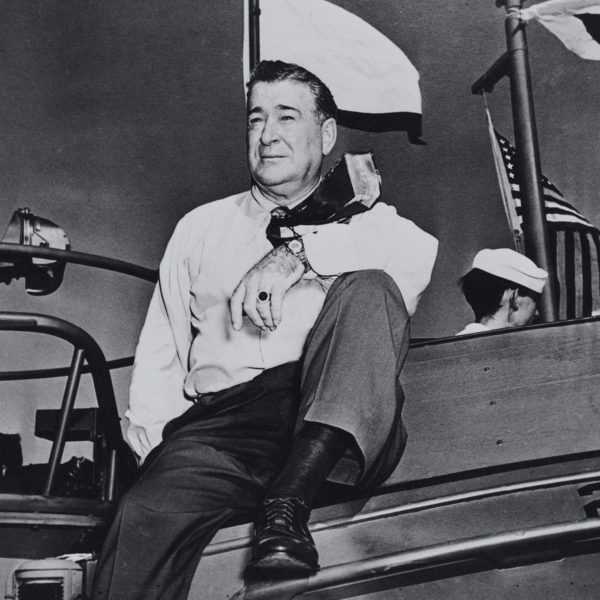Capitalism in WWII: The Arsenal of Democracy
American industrial might defeats the Axis and sets the course for decades of prosperity
In 1940, President Roosevelt faced a history-defining decision: should he involve the United States in the escalating global conflict? The First World War had left the country reeling. Isolationism and nationalism reared its head, exacerbated by the hardships of the Great Depression. However, across the Atlantic, fascism had taken hold in Germany and Italy, where Hitler and Mussolini were bolstering arms at a rapid pace. After the fall of France, it seemed the United Kingdom was the only major power left standing between the Axis and control of Europe—and beyond.
To support the allies—without directly committing American troops—President Roosevelt sought to jumpstart production of war materials, transforming the United States into the “Arsenal of Democracy.” In the true spirit of a leader of one of the strongest capitalist governments in the world, he summoned the country’s top businessmen to the White House to advise him on how to pivot manufacturing to support the cause. Over 18 months, factories ramped up production and shifted their outputs. Refrigerators became airplanes. Silk dresses became parachute canopies. Typewriters became carbine rifles. By December 7, 1941, when the United States declared war on the Axis Powers, the American economy was mobilized for war.
The following four years saw unprecedented industrial, economic, military, and scientific advancements. Inventions and innovations included jet engines, the programmable computer, hand-held radios, radar-guided amphibious landing crafts—and the atomic bomb. Unemployment was at an all-time low of 1.2 percent as women, minorities, and the disabled received meaningful work. By the end of the war, the United States was producing two-thirds of all Allied military equipment and our military had become strongest, most technologically advanced forces in the world. $183 billion of arms had been manufactured: a staggering 86,000 tanks; 2.5 million trucks and half a million Jeeps; 286,000 warplanes; 8,800 naval vessels; 5,600 merchant ships; 434 million tons of steel; 2.6 million machine guns; and 41 billion rounds of ammunition.
As William Knudsen, president of General Motors and Roosevelt’s wartime director of production management put it, “We won because we smothered the enemy in an avalanche of production, the like of which he had never seen, nor dreamed possible.” By harnessing the principles of capitalism and the powerful free market economy, the United States became a world superpower, turned the tide of the Second World War, and ensured prosperity for global generations to come.
Here is the full transcript of the video:
Owen Glendening (OG), Associate Vice President of Education & Access, The National WWII Museum: This great deployment of the American economy in all its productive capacity, is how in World War II, America out produced its enemies.
Robert Citino (RC), Samuel Zemurray Stone Senior Historian, The National WWII Museum: In the 1930s, the country is still sunk in the Great Depression. So while America was still the world’s largest economy, huge segments of it were more or less lying fallow we might say.
OG: The United States, United Kingdom, and France had not come back after World War I in anything like the robust way that the authoritarian regimes did by militarizing their economies.
NEWSREEL – Nazis were spending millions arming Germany to the teeth.
RC: And America had a pitifully small army and not much bigger of a navy and almost no air force to speak of.
TITLE – 1940
OG: By the time we get to 1940, something was brewing and something was coming.
RC: America is not yet at war—but the Nazis definitely are. Hitler in Germany, Mussolini in Italy, the militarist faction in Tokyo. But at the same time a large chunk of the American population was isolationist. They wanted no part of a war.
OG: They thought we could simply look inward and look to those oceans to keep us out of any conflict.
TITLE – Two years before Pearl Harbor: In a ‘Fireside Chat’ Roosevelt explains how America will avoid the war.
FDR – It is serious enough to live in a world torn by wars on other continents. It is our national duty to keep those wars out of the Americas.
RC: And then Germany won this dramatic military campaign in France driving the British off the continent. Hitler, he was looking across the English Channel and already launching his bombers against England.
TITLE – Summer 1940: Nazis begin assault on Britain.
RC: But Britain was running out of war materiel. They needed tanks, bombers, and guns to keep fighting.
OG: FDR realized if Britain was to be resupplied, and to keep Britain in the game, America would be solely be the economy that could do that. The question, though, was mobilization. We had a lot of idle capacity in our factories, in our capital, in our labor supply that needed to be called into action.
FDR – The people of Europe who are defending themselves do not ask us to do their fighting. They ask us for the implements of war: planes, the tanks, the guns. We must be the great arsenal of democracy.
OG: It was a total change in demand for what the industrial economy here needed to be producing.
RC: FDR tells Congress we need to increase production to more than 50,000 planes per year.
OG: Hermann Göring, one of the Germans’ military leaders, is purported to have said “Oh, the Americans, they’re good at razor blades and washing machines, we don’t need to worry.” But, of course, he misses the point.
RC: I think it’s safe to say that Franklin Delano Roosevelt was not the candidate of big business.
OG: But he calls “Big” Bill Knudsen from General Motors, who was a genius for the vast production that Ford was able to achieve, the assembly line and all those kinds of things. Knudsen stood up and said, “Yes sir, what can I do?” and FDR said, “Need your help. How do we do this, and will you lead it?”
RC: Bill Knudsen gave up his salary. Came to Washington.
OG: Went to his hotel room and mapped out for FDR, in a couple of days, a plan that he thought in 18 months would turn the industrial capacity of the country into this amazing machine that could support Britain, to keep them in the fight. Knudsen realized there were a lot of profound changes required.
He tells FDR that “you’ve really gotta change your procurement policies for us to get on with it, and if you can do that, we will get on with it.” He had such rapport with the titans of industry that he could call people, convincing them that there was a broader national cause to put people back to work and to put the productive capacity at its highest level.
RC: And in America, the only way we were going to do that is let business be business and let producers produce.
NEWSREEL – Conversion from peacetime work to total war production goes at top speed. Yesterday this was an underwear factory. Today, it turns out cloth for gas masks.
OG: If you could make silk evening dresses, you could make parachutes. People who are making typewriters all of a sudden making rifles. People who made refrigerators, you know how bend sheet metal, you can make airplanes now. Ford ends up producing B-24s.
RC: And of course, in December 1941, the debate about whether America would involve itself in World War II suddenly became moot. But we had already done 18 months of hardcore work on retooling the economy and that meant we were prepared to gear up to very rapid production in 1942.
That was when businessmen realized, in terms of the raw numbers, the integrated, justly paid workforce was absolutely essential to the building of the arsenal of democracy. So alongside millions of women who entered the industrial workforce were African-Americans in great numbers.
By 1943 and 1944, the US is operating at peak production.
NEWSREEL – It’s the biggest industrial program in the world. The productive might of a nation unified for Freedom’s battle.
RC: Perhaps the best example is shipbuilding. It used to take months. But the Kaiser construction firm out west actually built a Liberty ship in five days.
NEWSREEL – The enemy didn’t count this ability to change among our secret weapons.
OG: It’s another example of what the shear strength and capacity of a free market economy put to a purpose can accomplish.
RC: The free market was absolutely essential to the building of the arsenal of democracy and, given the fact that we were fighting Hitler, to the benefit of the entire world.

